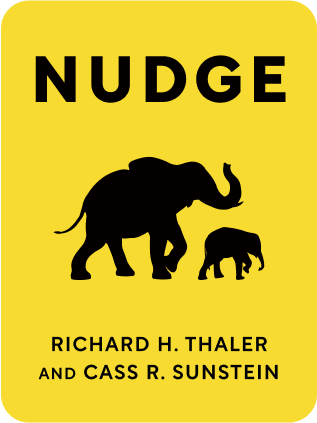

This article is an excerpt from the Shortform summary of "Nudge" by Richard H. Thaler and Cass R. Sunstein. Shortform has the world's best summaries of books you should be reading.
Like this article? Sign up for a free trial here .
What are some Nudge techniques? How do Nudge techniques use the heuristics and biases people have?
Nudge techniques are used to correct bad decisions made automatically by people. These automatic decisions are made as a result of heuristics.
Read on to learn about the heuristics corrected by Nudge techniques.
Heuristics That Need Nudge Techniques
Heuristics—more commonly known as “rules of thumb”—allow us to make judgments when we aren’t sure of the right answer. In many cases, they’re helpful—for example, when we estimate distances based on landmarks or seek a rental apartment that costs no more than a third of our monthly earnings. But, as discovered by psychologists Amos Tversky and Daniel Kahneman, our tendency to rely on rules of thumb also leads to systemic biases that skew our judgements. (Shortform note: Read our summary of Kahneman’s Thinking, Fast and Slow here.) Tversky and Kahneman identified three common heuristics and the misapprehensions each entails.
Tversky and Kahneman’s three heuristics aren’t the only habits of thinking that can get us into trouble. Thaler and Sunstein identify four further biases that cloud our judgments and lead to systematic errors. Nudge techniques can correct for these or take advantage of them.
Unrealistic Optimism
Even when faced with the statistical likelihood of failure or mediocrity, individual humans persist—predictably—in believing themselves the exception to these statistics.
Thaler offers an example from his class in Managerial Decision Making. Before the class begins, Thaler has his students fill out a survey that invites them to predict in which decile their final grade for the course will fall. Even though the students understand that only 10% of the class will be in the top decile and only 50% of the class will be in the top five deciles—these students are MBAs and get the basic math—typically less than 5% of the class believes its grade will fall below the median and more than 50% believes its final grade will fall in the top two deciles!
Examples of this type abound. Ninety percent of drivers believe their driving skills are above-average; 94% of professors at a large university believed they were above-average professors; and most newlyweds believe their chances of divorcing are near zero (even though 50% of marriages end in divorce).
Where unbridled optimism becomes problematic is, for example, in the areas of personal health. Despite the widely known health risks, smokers tend to believe that they’re less likely to get lung cancer than nonsmokers, and gay men systematically underestimate their likelihood of contracting AIDS. Nudge techniques can help correct for unrealistic optimism with additional information.
Aversion to Loss
Human beings are naturally predisposed to be unhappier with losses than they are happy with gains. Consequently, our behavior consistently reveals a hesitancy to risk loss, even when the gains of a particular choice or course of action might be significant.
Numerous studies reflect humans’ loss aversion. In one experiment, half of the students in a class was given coffee mugs, the other half large chocolate bars. Even though the dollar value of the two objects was about the same, only 10% of the students traded. Simply put, we’re more afraid of suffering a loss than realizing a gain. Nudge strategies can recognize bad decisions because of loss aversion and try to encourage a correction.
Status Quo Bias and Nudge Strategies
Closely related to humans’ aversion to loss is our “status quo bias.” On the balance, even if our current situation leaves much to be desired, we tend to favor present circumstances over change.
In many areas, status quo bias is simply an interesting human quality—for example, when students choose a seat on their first day of class and continue to sit in the same seat the rest of the semester.
In other areas, however, status quo bias can cause real harm. Consider retirement plans like 401(k)s. A study of college professors conducted in the late ’80s found that, over the course of their entire career, the median number of changes the professors made to their 401(k) asset allocation was zero. Some of the professors, who’d married and had children over the years, still had their parents listed as their beneficiaries! Nudge strategies can encourage periodic review of 401(k) asset allocation.
Another way to think about status quo bias is as the “whatever” heuristic. When we watch an old favorite on network TV and then, out of sheer laziness or inertia, watch the show that follows—saying, in essence, “whatever”—we’re guilty of status quo bias.
Framing for Nudge Techniques
When it comes to statistics and probability, humans are especially susceptible to “framing effects.” That is, the way data is “framed” can drastically affect our response to it.
To illustrate the point, think of doctors’ prognoses. If a doctor tells you that 90 out of a 100 people who’ve had a certain procedure are still alive after five years, you’d probably consider the procedure relatively safe. If the doctor tells you ten out of 100 people died after having the procedure, you might be less inclined to have that procedure, even though the success rate is exactly the same. (Incredibly, doctors themselves are susceptible to this bias: Doctors will prescribe a treatment more or less depending on how its success rate is framed.)
Credit card companies showed an intuitive understanding of framing effects in their Nudge techniques as their product became more popular in the 1970s. Since merchants are assessed a fee by the credit card companies (typically 1% on each credit card transaction), the merchants wanted to charge their cash and credit customers two different prices. When a bill was introduced in Congress to allow merchants this option (over the credit card companies’ objections), the credit card companies tried to change the bill’s language: they wanted cash customers to get a “discount” rather than credit customers be assessed a “surcharge.”

———End of Preview———
Like what you just read? Read the rest of the world's best summary of Richard H. Thaler and Cass R. Sunstein's "Nudge" at Shortform .
Here's what you'll find in our full Nudge summary :
- Why subtle changes, like switching the order of two choices, can dramatically change your response
- How to increase the organ donation rate by over 50% through one simple change
- The best way for society to balance individual freedom with social welfare






